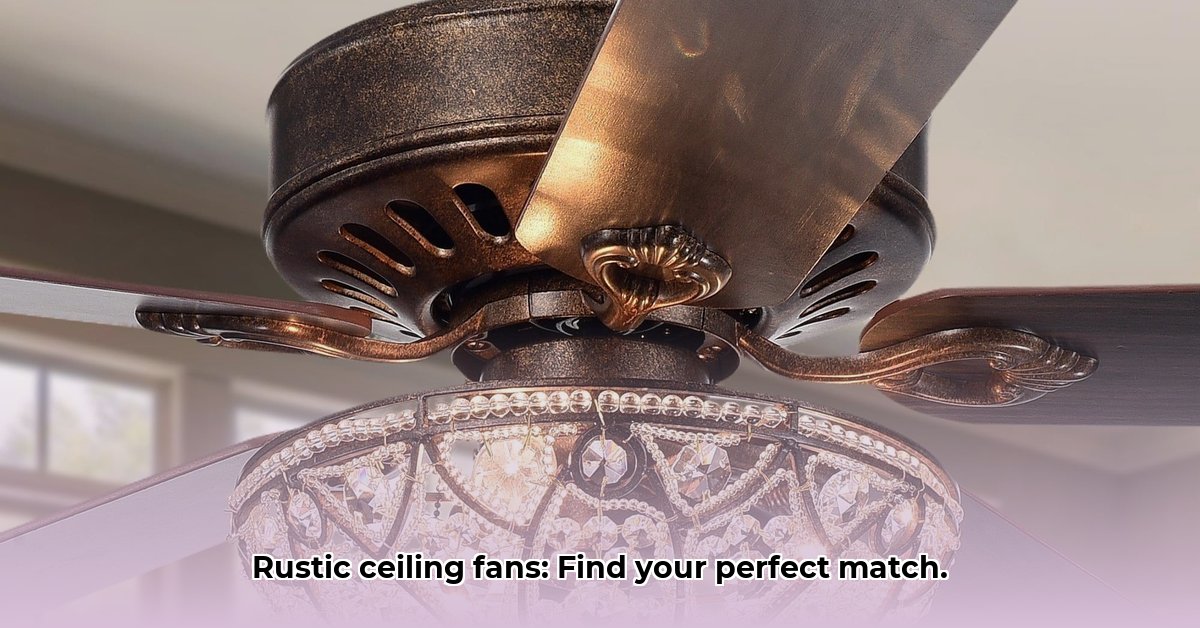Thinking about adding a rustic ceiling fan with a light to your home? It can really change the look and feel of a room, but choosing the right one can be tricky. This guide will walk you through everything, from understanding the tech specs (it’s easier than it sounds!) to picking a style that fits your home perfectly. We’ll even show you some of the best fans out there and give you tips to make installation a breeze. For more rustic ceiling fan options, check out this helpful resource. Let’s find the perfect fan for you!
Rustic Ceiling Fans with Lights: Your 2025 Buyer’s Guide
Securing the right design and functionality with a ceiling fan.
Finding the perfect rustic ceiling fan with a light isn’t just about picking a pretty fixture; it’s about enhancing your home’s comfort and style to meet modern design expectations. Let’s break down how to choose the right one for you, adding better home decor.
Decoding the Specs: What All Those Numbers Mean
Understanding technical specification of rustic ceiling fans.
Before diving into styles, let’s tackle the technical stuff – but don’t worry, we’ll keep it simple! You’ll encounter terms like CFM, decibels (dB), wattage, and lumens. Think of these as your fan’s vital stats:
- CFM (Cubic Feet per Minute): This measures how much air the fan moves. Higher CFM means a more powerful breeze – great for larger rooms or those that get really toasty. Consider a CFM of 4000-6000 for optimal performance in larger spaces.
- Decibels (dB): This measures how loud the fan is. Lower dB means a quieter operation. Look for fans rated below 40 dB for near-silent operation.
- Wattage: This indicates how much electricity the fan uses. Lower wattage usually means more energy efficiency and lower electricity bills. Consider fans with Energy Star ratings for the best energy savings.
- Lumens: This measures the brightness of the light. Higher lumens mean a brighter light, which is perfect if you want a room well-lit even without other lamps. Aim for 800-1600 lumens for ample lighting in most rooms.
Imagine CFM as the fan’s “muscle,” dB its “voice,” wattage its “appetite,” and lumens its “brightness.” You want a good balance of all these factors, especially when considering energy-efficient models.
Sizing Up Your Space: Room Dimensions and Ceiling Height
Tips for measuring your room space.
Choosing the right size fan is crucial. Too small a fan will struggle to cool a large room, leaving you sweltering. Too large a fan might feel like a hurricane in a small space.
Here’s what to consider:
- Measure your room: Get the length and width of the room you’re planning to install the fan in. Many online calculators can help you determine the ideal blade diameter based on these measurements. For example, a 12×15 foot room (180 sq ft) typically needs a 52-inch fan.
- Ceiling height: This influences your mounting options. Flush mounts are perfect for low ceilings (less than 8 feet), attaching directly to the ceiling. For higher ceilings (8 feet or more), a downrod extends the fan downwards, providing better airflow and a more balanced look, which ensures optimal performance. A general rule is to have at least 7 feet of clearance between the floor and the bottom of the fan.
- Room type: A spacious living room will likely need a larger, more powerful fan than a cozy bedroom. Consider the purpose of the room when selecting fan size and features. Bedrooms, for instance, benefit from quieter operation.
Defining “Rustic”: Finding Your Perfect Style
How to pinpoint your ideal rustic design for your home.
“Rustic” is a broad term, encompassing many styles. Think about the overall aesthetic you’re aiming for:
- Farmhouse: Think warm wood tones, possibly distressed finishes, and a generally cozy, inviting feeling. This style often incorporates elements reminiscent of a traditional farm setting. These fans often have a simpler, more classic design. Common materials include reclaimed wood and oil-rubbed bronze.
- Industrial: This style typically features metal accents, exposed bulbs, and a more utilitarian look – often incorporating dark metals and clean lines. They often have a slightly more modern feel within the overall rustic theme when you want to add better home decor. Edison-style bulbs are frequently used in industrial rustic fans.
- Transitional: This is a blend of rustic and modern styles. You might find fans with rustic wood elements but a cleaner, more contemporary design. It’s a good choice for those who don’t want a purely traditional look, providing a versatile way to match your home’s style. Neutral colors and sleek lines are typical characteristics.
- Coastal Rustic: This combines nautical elements with rustic charm. Think weathered wood, rope accents, and finishes that evoke a seaside feel. Paler wood tones and blues or greens are often used.
Browse online images and magazines. Pay attention to details – the wood types (oak, pine, reclaimed wood?), metal finishes (black, bronze, weathered steel?), and the overall shape of the fan. What feels right for your home? Consider how the fan will complement existing furniture and decor.
Top Rustic Ceiling Fans with Lights for 2025
Comparative table for various styles and price points
The following table shows examples of fans that represent different styles and price points. Remember, specific models and pricing can change quickly, so always check the latest availability and reviews before purchasing a fan.
| Model Name (Example) | Style | Blade Span (inches) | CFM (approx) | dB (approx) | Lumens (approx) | Wattage (Fan/Light) | Price Range (USD) | Pros | Cons |
|---|---|---|---|---|---|---|---|---|---|
| “The Homesteader” | Farmhouse | 52 | 5000 | 45 | 1800 | 60W/20W | $250-$350 | Powerful airflow, warm wood finish, energy-efficient LED lighting, reversible motor for seasonal use | May be slightly noisy at higher speeds, limited finish options. |
| “The Foundry” | Industrial | 56 | 4800 | 40 | 1500 | 70W/15W | $300-$400 | Sleek metal design, durable construction, strong light output, integrated remote control | Slightly less airflow than some farmhouse styles, may not suit all decor styles. |
| “The Bridge” | Transitional | 52 | 4500 | 38 | 1700 | 65W/18W | $350-$450 | Quiet operation, elegant design, good balance of rustic and modern elements, multiple speed settings | Higher price point, light output may be insufficient for larger rooms. |
| “The Rustic Charm” | Farmhouse | 60 | 5500 | 48 | 2000 | 75W/25W | $400-$500 | Very powerful airflow, bright lighting, high-quality materials, suitable for large rooms | Noisier than some competitors, more expensive, bulkier design. |
| “The Modern Farmhouse” | Modern Rustic | 52 | 4200 | 42 | 1600 | 62W/16W | $280-$380 | Stylish, efficient, reliable, blends rustic and contemporary aesthetics effectively, easy to install | Fewer style variations within the overall Modern Rustic designation, airflow may be insufficient for very large rooms. |
| “The Coastal Breeze” | Coastal Rustic | 52 | 4700 | 43 | 1700 | 63W/17W | $320-$420 | Attractive coastal design, quiet operation, corrosion-resistant materials suitable for damp locations, remote control included | May not suit non-coastal decor styles, light output may be too dim for some users. |
(Note: These are example models. Research current market options to find the best fit for your needs such as Casablanca Fan Company, Hunter Fan Company and Fanimation. Prices and specifications are subject to change.)
Installation & Safety: Important Considerations
What you should know about fan fitting.
Proper installation is key for both safety and optimal performance. Always follow the manufacturer’s instructions precisely. Remember these crucial safety points:
- Turn off the power: Before you begin any work, switch off the power at the breaker box. This prevents serious electrical shock. Use a voltage tester to confirm the power is off.
- Secure mounting: Ensure the fan is securely mounted to the ceiling joist. A poorly secured fan is a serious hazard. Use appropriate mounting hardware for your ceiling type (e.g., wood screws for wood joists, toggle bolts for drywall). Many fans come with specific mounting brackets – use them!
- Professional help: If you aren’t comfortable with electrical work, call a qualified electrician. It’s better to be safe than sorry especially when you want to add better home decor! Electrical work can be dangerous, and incorrect wiring can lead to fire hazards.
- Balance the blades: After installation, check if the fan blades are balanced. Wobbling can cause noise and premature wear. Most fans come with a balancing kit.
Finding Your Perfect Match
Summarizing the Key Consideration for Rustic Ceiling Fan.
Choosing a rustic ceiling fan with a light is a
- Glass Tile Shower Ideas to Create a Stunning Bathroom Space - December 7, 2025
- Glass Wall Tile Ideas for Kitchens and Bathrooms - December 6, 2025
- Glass Tile Bathroom: Create a Beautiful, Easy-Clean Space - December 5, 2025










